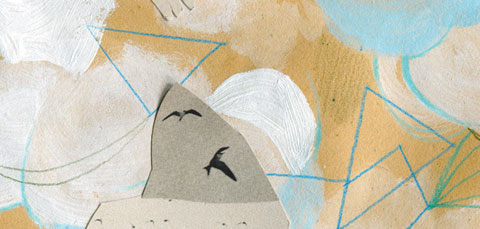
This article is part of our December theme, which focuses on one of the least appreciated but most fundamental aspects of well-being: housing. Read our Editorial for more on this theme.
It was terribly cold and nearly dark on the last evening of the old year, and the snow was falling fast. In the cold and the darkness, a poor little girl, with bare head and naked feet, roamed through the streets … She had drawn her little feet under her, but she could not keep off the cold; and she dared not go home, for she had sold no matches, and could not take home even a penny of money. Her father would certainly beat her; besides, it was almost as cold at home as here, for they had only the roof to cover them, through which the wind howled, although the largest holes had been stopped up with straw and rags. Her little hands were almost frozen with the cold. Ah! perhaps a burning match might be some good, if she could draw it from the bundle and strike it against the wall, just to warm her fingers.
– Hans Christian Anderson “The Little Match Girl”
Children are emerging as the new face of homelessness in Australia. In 2009–10, more than 84,000 children (under 18 years) across Australia accessed a specialist homelessness service accompanying their parent or guardian (Australian Institute of Health and Welfare). This is equivalent to one in sixty Australian children, and one in every thirty-eight children is aged four years or younger. The actual number of homeless families and children in need of services is likely to be much higher, as these only capture those who have gained access or have tried to access a service. Unsurprisingly, indigenous Australians are over-represented in accessing specialist homelessness services.
While children become homeless for many reasons, their experiences once homeless tend to follow a familiar trajectory.
Sadly, stories like Anderson’s fable of the little match girl – in which a child is scared of returning home due to a crisis in a familial situation – are not uncommon. Many are driven onto the streets due to domestic violence and/or relationship breakdowns, whilst others become homeless when their families lose their homes due to a lack of affordable housing, wage poverty or other structural problems. The growing trend for councils to enact move-on powers often targets youths who spend time on the streets due to difficult family situations and pushes them to relocate to even more marginalised areas.
While children become homeless for many reasons, their experiences once homeless tend to follow a familiar trajectory. They often remain homeless or precariously houseless for long periods of time, and drop out of the education and welfare systems, which leads to longer waits for public housing. Numerous quantitative studies have provided evidence of mental health problems and stress levels among children who experience homelessness, and consequential behavioural and development delays.
The ‘Youth Step Up’ Program is unique … disadvantaged young people are given the opportunity to help others who are even more in need.
Fortunately, there has been growing awareness of youth homelessness in Australia. White papers such as The Road Home and national strategies for childhood development have highlighted the undercurrent of social conditions that put children at risk. Prevention, early intervention and crisis support are promoted as the three keys areas for positive action. The focus of these programs, to their credit, aims to reach down to the children who are at risk and pull them into a more supported, safe network.
In contrast, there are other programs that aim not to reach down to the children, but to lift up their hearts. Programs like Father Chris Riley’s ‘Youth Step Up’ are on the forefront of this movement. The ‘Youth Step Up’ Program is unique in that it incorporates a ‘Service Learning’ component, where disadvantaged young people are given the opportunity to help others who are even more in need. For example, in 2011, Father Chris Riley and a group of seven young people travelled to Timor Leste (East Timor) to provide support and activities for young orphans at the Orphanage in Baguia.
… compassion is a tool of empowerment …
In most cases, the children within the program have suffered from abuse and family breakdowns. They have lived a life absent of people who should care for them. When asked in an interview why he believes these children should be put to the service of others, Father Chris Riley was adamant that precisely because they had not been cared for themselves, they should be given the opportunity to care for others so as to experience that connection. From past experiences, children who help others who are worse off than themselves gain another lens through which to see the world, and this allows them to develop empathy and compassion. The Father emphasised that compassion is a tool of empowerment, it allows the children to lift themselves up, in their self-image and as well as in the eyes of others. It is an invaluable experience for young people as it helps to break the cycles of neglect that can become generational.
Indeed, as Thomas Browne Sr. once wrote, ‘by compassion we make others’ misery our own, and so, by relieving them, we relieve ourselves also’. As one reflects on Anderson’s fable, it is notable that it is by her own hand that she strikes her matches, and it is by her own imagination that she finds fulfilment. Perhaps the relief from the cold that the little match girl gained from striking her last match, by her own hand, was that of compassion.
On 24 November 2011, Father Chris Riley, the founder of Youth off the Streets, was named NSW Australian of the Year for 2012.


